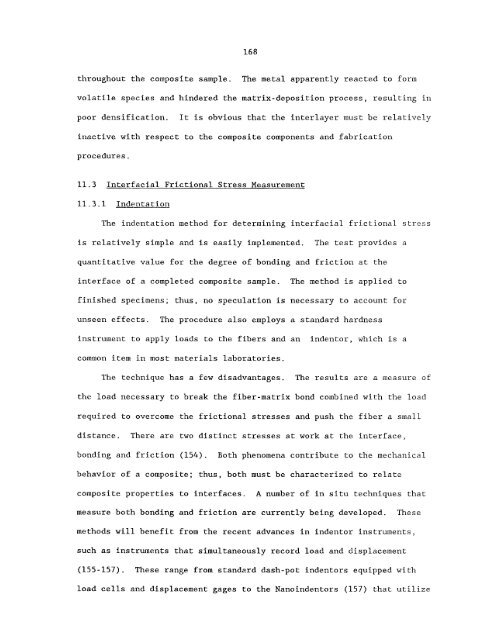Characterization and control of the fiber-matrix interface in ceramic ...
Characterization and control of the fiber-matrix interface in ceramic ...
Characterization and control of the fiber-matrix interface in ceramic ...
You also want an ePaper? Increase the reach of your titles
YUMPU automatically turns print PDFs into web optimized ePapers that Google loves.
168<br />
throughout <strong>the</strong> composite sample. The metal apparently reacted to form<br />
volatile species <strong>and</strong> h<strong>in</strong>dered <strong>the</strong> <strong>matrix</strong>-deposition process, result-<strong>in</strong>g <strong>in</strong><br />
poor densification. It is obvious that <strong>the</strong> <strong>in</strong>terlayer must be relatively<br />
<strong>in</strong>active with respect to <strong>the</strong> composite components <strong>and</strong> fabrication<br />
procedures.<br />
11.3 Interfacial Frictional Stress Measurement<br />
11.3.1 Indentation<br />
The <strong>in</strong>dentation method for determ<strong>in</strong><strong>in</strong>g <strong>in</strong>terfacial frictional stress<br />
is relatively simple <strong>and</strong> is easily implemented. The test provides a<br />
quantitative value for <strong>the</strong> degree <strong>of</strong> bond<strong>in</strong>g <strong>and</strong> friction at <strong>the</strong><br />
<strong><strong>in</strong>terface</strong> <strong>of</strong> a completed composite sample. The method is applied to<br />
f<strong>in</strong>ished specimens; thus, no speculation is necessary to account for<br />
unseen effects. The procedure also employs a st<strong>and</strong>ard hardness<br />
<strong>in</strong>strument to apply loads to <strong>the</strong> <strong>fiber</strong>s <strong>and</strong> an <strong>in</strong>dentor, which is a<br />
common item <strong>in</strong> most materials laboratories.<br />
The technique has a few disadvantages. The results are a measure <strong>of</strong><br />
<strong>the</strong> load necessary to break <strong>the</strong> <strong>fiber</strong>-<strong>matrix</strong> bond comb<strong>in</strong>ed with <strong>the</strong> load<br />
required to overcome <strong>the</strong> frictional stresses <strong>and</strong> push <strong>the</strong> <strong>fiber</strong> a small<br />
distance. There are two dist<strong>in</strong>ct stresses at work at <strong>the</strong> <strong><strong>in</strong>terface</strong>,<br />
bond<strong>in</strong>g <strong>and</strong> friction (154). Both phenomena contribute to <strong>the</strong> mechanical<br />
behavior <strong>of</strong> a composite; thus, both must be characterized to relate<br />
composite properties to <strong><strong>in</strong>terface</strong>s, A number <strong>of</strong> <strong>in</strong> situ techniques that<br />
measure both bond<strong>in</strong>g <strong>and</strong> friction are currently be<strong>in</strong>g developed.<br />
These<br />
methods will benefit from <strong>the</strong> recent advances <strong>in</strong> <strong>in</strong>dentor <strong>in</strong>struments,<br />
such as <strong>in</strong>struments that simultaneously record load <strong>and</strong> displacement<br />
(155-157). These range from st<strong>and</strong>erd dash-pot <strong>in</strong>dentors equipped with<br />
load cells <strong>and</strong> displacement gages to <strong>the</strong> Nano<strong>in</strong>dentors (157) that utilize

















